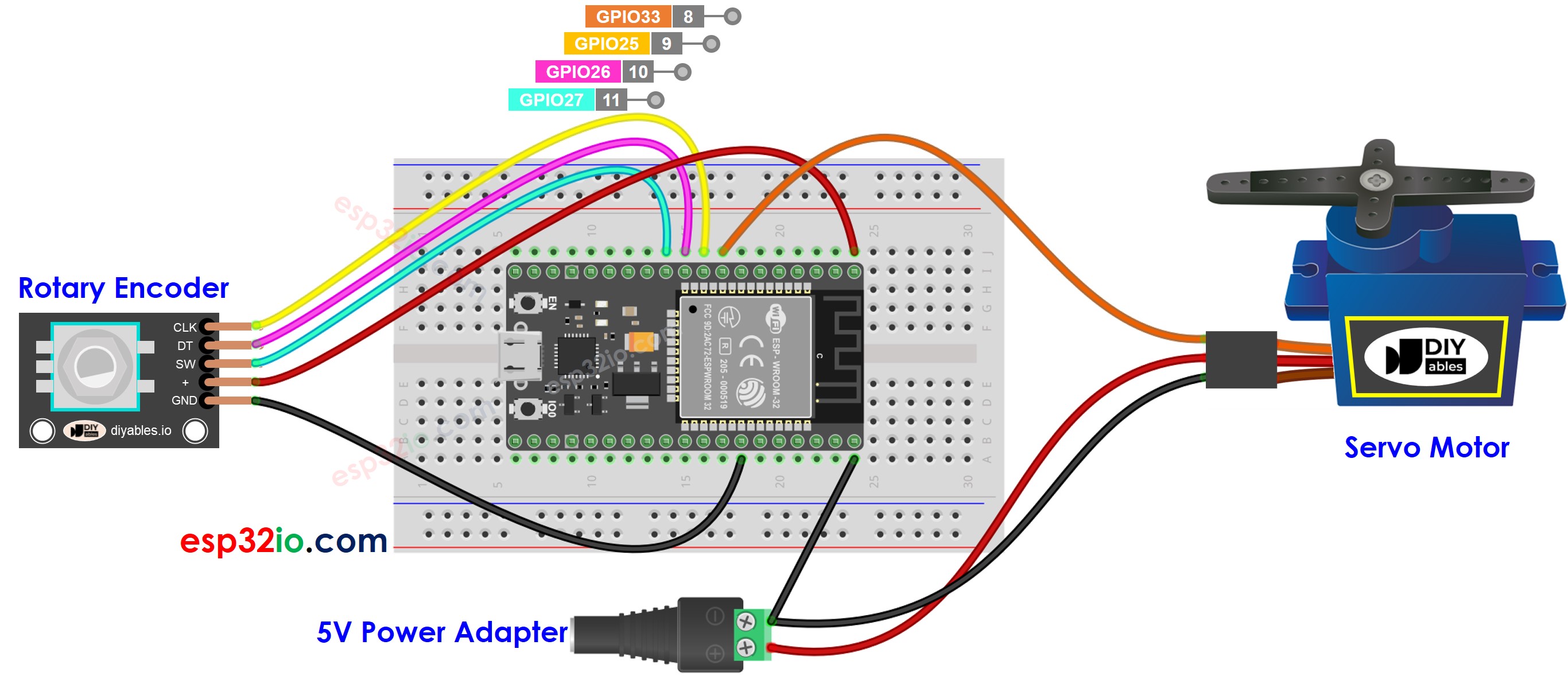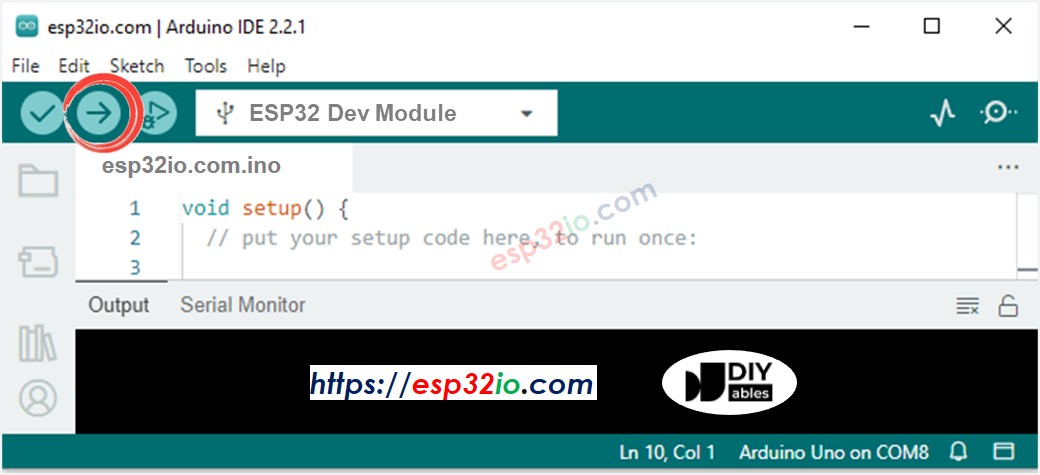ESP32 - Moteur servo à encodeur rotatif
Dans ce tutoriel, nous allons apprendre à programmer l'ESP32 et l'encodeur rotatif pour contrôler l'angle du moteur servo.
Préparation du matériel
Ou vous pouvez acheter les kits suivants:
| 1 | × | Kit de Démarrage DIYables ESP32 (ESP32 inclus) | |
| 1 | × | Kit de Capteurs DIYables (30 capteurs/écrans) | |
| 1 | × | Kit de Capteurs DIYables (18 capteurs/écrans) |
Divulgation : Certains des liens fournis dans cette section sont des liens affiliés Amazon. Nous pouvons recevoir une commission pour tout achat effectué via ces liens, sans coût supplémentaire pour vous. Nous vous remercions de votre soutien.
À propos du moteur servo et de l'encodeur rotatif
Vous ne connaissez pas le moteur servo et le codeur rotatif, y compris leurs brochages, fonctionnalités et programmation ? Explorez des tutoriels complets sur ces sujets ci-dessous :
Diagramme de câblage

Cette image a été créée avec Fritzing. Cliquez pour agrandir l'image.
Si vous ne savez pas comment alimenter l'ESP32 et d'autres composants, consultez les instructions dans le tutoriel suivant : Comment alimenter l'ESP32..
Code ESP32
/*
* Ce code ESP32 a été développé par newbiely.fr
* Ce code ESP32 est mis à disposition du public sans aucune restriction.
* Pour des instructions complètes et des schémas de câblage, veuillez visiter:
* https://newbiely.fr/tutorials/esp32/esp32-rotary-encoder-servo-motor
*/
#include <ESP32Servo.h>
#define CLK_PIN 25 // ESP32 pin GPIO25 connected to the rotary encoder's CLK pin
#define DT_PIN 26 // ESP32 pin GPIO26 connected to the rotary encoder's DT pin
#define SW_PIN 27 // ESP32 pin GPIO27 connected to the rotary encoder's SW pin
#define SERVO_PIN 33 // ESP32 pin GPIO33 connected to the servo motor
#define DIRECTION_CW 0 // clockwise direction
#define DIRECTION_CCW 1 // counter-clockwise direction
int counter = 0;
int direction = DIRECTION_CW;
int CLK_state;
int prev_CLK_state;
int angle = 90;
Servo servo; // create servo object to control a servo
void setup() {
Serial.begin(9600);
// configure encoder pins as inputs
pinMode(CLK_PIN, INPUT);
pinMode(DT_PIN, INPUT);
// read the initial state of the rotary encoder's CLK pin
prev_CLK_state = digitalRead(CLK_PIN);
servo.attach(SERVO_PIN); // attaches the servo on pin 9 to the servo object
servo.write(angle);
}
void loop() {
// read the current state of the rotary encoder's CLK pin
CLK_state = digitalRead(CLK_PIN);
// If the state of CLK is changed, then pulse occurred
// React to only the rising edge (from LOW to HIGH) to avoid double count
if (CLK_state != prev_CLK_state && CLK_state == HIGH) {
// if the DT state is HIGH
// the encoder is rotating in counter-clockwise direction => decrease the counter
if (digitalRead(DT_PIN) == HIGH) {
direction = DIRECTION_CCW;
counter--;
angle -= 2; // you can change this resolution
} else {
// the encoder is rotating in clockwise direction => increase the counter
direction = DIRECTION_CW;
counter++;
angle += 2; // you can change this resolution
}
if (angle < 0)
angle = 0;
else if (angle > 180)
angle = 180;
// sets the servo angle according to the counter
servo.write(angle);
Serial.print("COUNTER: ");
Serial.print(counter);
Serial.print(" | ANGLE: ");
Serial.println(angle);
}
// save last CLK state
prev_CLK_state = CLK_state;
}
Étapes rapides
- Si c'est la première fois que vous utilisez un ESP32, consultez Installation du logiciel ESP32..
- Réalisez le câblage comme sur l'image ci-dessus.
- Connectez le tableau ESP32 à votre PC via un câble micro USB.
- Ouvrez Arduino IDE sur votre PC.
- Sélectionnez la bonne carte ESP32 (par exemple ESP32 Dev Module) et le port COM.
- Connectez l'ESP32 au PC via un câble USB.
- Ouvrez Arduino IDE, sélectionnez la bonne carte et le port.
- Copiez le code ci-dessus et ouvrez-le avec Arduino IDE.
- Cliquez sur le bouton Upload sur Arduino IDE pour télécharger le code sur ESP32.

- Ouvrez le moniteur série
- Tournez l'encodeur rotatif
- Observez la rotation du moteur servo
- Consultez le résultat sur le moniteur série
COM6
COUNTER: 0 | ANGLE: 90
COUNTER: 1 | ANGLE: 92
COUNTER: 2 | ANGLE: 94
COUNTER: 3 | ANGLE: 96
COUNTER: 4 | ANGLE: 98
COUNTER: 5 | ANGLE: 100
COUNTER: 6 | ANGLE: 102
Autoscroll
Clear output
9600 baud
Newline
Explication du code
Lisez l'explication ligne par ligne dans les lignes de commentaire du code source !
